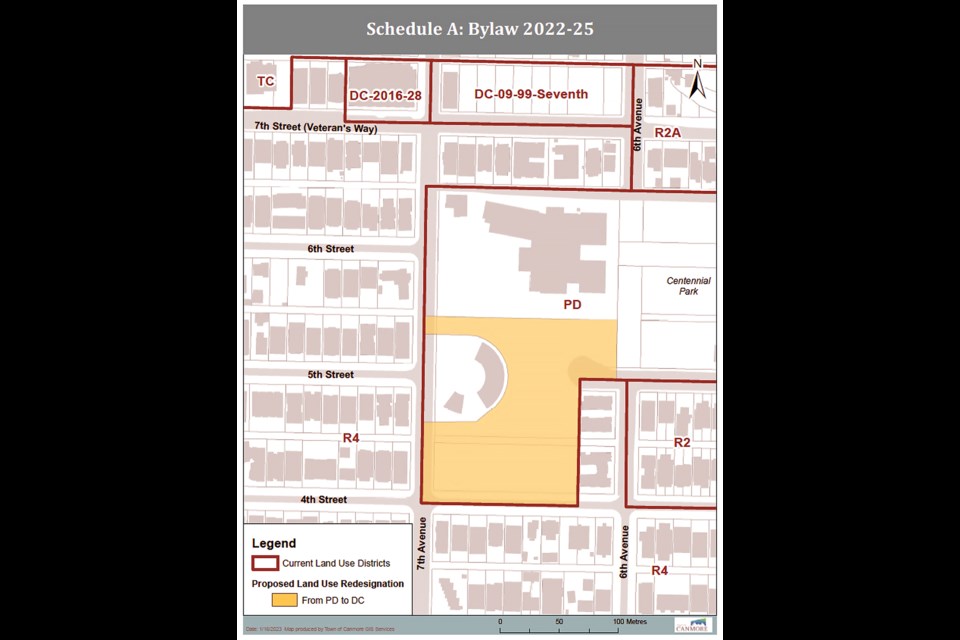CANMORE – A direct control district will be included in the Lawrence Grassi Middle School area redevelopment plan.
Following a public hearing at its Tuesday (May 2) meeting, Canmore council unanimously approved creation of a direct control district – which are customized land use designations that allow a specific set of rules because of uniquie characteristics or innovative design, for example, for a property or in this case, an entire development plan.
“The vision that’s being put forward by Canadian Rockies Public Schools (CRPS) for this site might not be the vision that others see for it, but there is incredible value to what is being proposed," said Coun. Tanya Foubert.
"I don’t think there’s another example that contributes a higher percentage of units on a development for what I would call future community benefit through the vital homes program as well as the employee housing for staff at CRPS.”
Mayor Sean Krausert said the plans align with both the area redevelopment plan (ARP), but also the practices in Canmore.
“It takes into account those concerns as best as possible,” he said.
Though the ARP was approved in 2022, the direct control district is a redesignation of a section of the area rather than a reopening of the entire plan.
The creation of the direct control district will help with design flexibility, particularly with adding green energy technology, said Chris Sparrow, the principal of MTA Urban Design during first reading in April.
It will allow Town planning staff to have the roof height variance go from 20 per cent of roof areas exceeding a maximum height allowance to just 10 per cent if the architecture would be enhanced, or if the view from across the street isn’t impaired more than would be created by a building of the maximum height measured from the front setback.
Debbie McKibbin, the deputy superintendent for CRPS, said the housing plan is “critical to the viability of our school board.”
She gave an example of three school staff resigning in the last week of April due to the high cost-of-living, noting staff housing could assist with this as well as create a legacy fund to help financially sustain the school board.
While council and the proponent praised the potential for the development, several residents spoke and wrote against the DC district during the public hearing. There were eight speakers and 14 letters – with 13 opposed to the proposal.
Among the concerns were traffic, access points for vehicles to south Canmore, parking, homes potentially going to non-locals and emergency services accessing the area.
Stan Bernbaum, a long-term resident of Canmore, said he was concerned with the “ultra-high density” of the ARP and increased height of buildings compared to others in the area.
He asked council to expand parking, extra green space be provided, any potential of short-term rentals be restricted and a shadow study be performed.
“We urge council to reject the rezoning application in its current form. However, in the case you decide to approve the zoning, we would ask Canmore town council take action to mitigate the effects of this development on the surrounding community," he said.
The ARP includes development of 120 residential units, including 20 earmarked as affordable housing for Canmore Community Housing (CCH), 20 employee housing units for teaching staff and a further five to be bought at market price for a residential tenancy agreement between CCH and CRPS.
The remaining 75 units from the roughly 1.5 hectares of land will be sold and go into a legacy fund for CRPS to financially help the school division.
In addition to creating housing, particularly employee housing for CRPS staff, goals include a pedestrian-focused development, creating housing diversity in the downtown area, adding to the neighbourhood character.
In the CRPS plan, some of the DC district factors would have a comprehensive site plan be provided with the first development permit application to show all site elements and housing diversity. The DC district would also require all parking spots to be electric vehicle charge capable.
A report to council noted a public engagement process on the specific direct control district wasn’t completed since CRPS felt “a rigorous public engagement process was undertaken as part of the development of the ARP and as this application conforms with the ARP, no further engagement is required.”
Town staff received about 40 letters, according to the report, which were given to CRPS and resulted in no changes.
The report highlighted concerns were raised around density and building height, loss of views, diminishing the character of the neighbourhood and loss of green space.
Coun. Wade Graham, a resident of south Canmore, said the addition of housing dedicated to Canmore Community Housing and CRPS staff has a “community mindedness”.
“I believe the relatively small negative impacts are far outweighed by the positive implications.”




